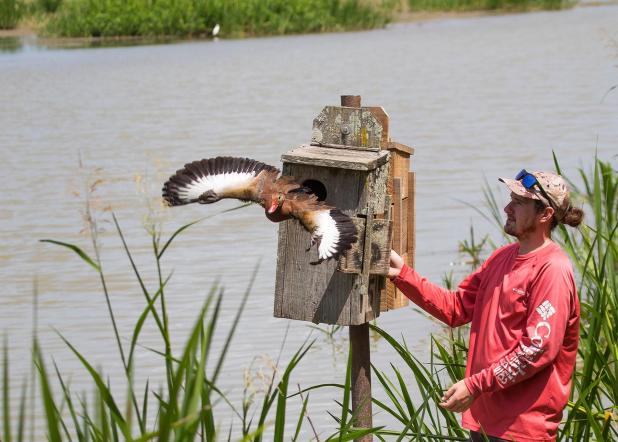
The Daily Review/John Flores
Dylan Bakner checks a wood duck nest box while a black-bellied whistling-duck flushes from inside.
John Flores: Doctoral student the ways of wood ducks and whistlers
Recently, a co-worker from Houma mentioned how many black-bellied whistling-ducks he had been seeing around his subdivision. I had to agree with him. From Sabine Pass near Lake Charles all the way to Pearl River along the Mississippi State line, there are literally thousands of this species of duck hanging out across Louisiana.
During the winter, large flocks of these whistling ducks hang out in the greater New Orleans area in places like Lafreniere and Audubon parks, as well as across the Mississippi River in Westwego, where there is a ready-made food source and safe refuge around grain elevators.
Black bellies can also be a real nuisance in urban areas. Locals complain about how noisy they are, how they defecate on buildings and even knock over bird feeders.
Essentially, for the past 20 to 30 years the black-bellied whistling-duck has been expanding its range further and further north from Mexico and south Texas, where now they appear to be firmly established as year round residents in Louisiana. Oddly enough, there has been very little scientific information published on this particular duck.
Recently, I reported a story about an ongoing study titled, “Regional Examination of the Contribution of Nest Boxes to Wood Duck Recruitment in the Southeast and Mid-Atlantic United States” that Louisiana was participating in.
Dylan Bakner, a PhD student with the LSU AgCenter for the past two years, has been working on this particular wood duck study, where one of the “Anticipated Outcomes” according to the project synopsis, is to gain new information on the nesting ecology of black-bellied whistling-ducks, which may open avenues of applied scientific inquiry relevant to the management of cavity-nesting species in Louisiana.
Bakner, who is originally from Waynesboro, Pennsylvania, and did his undergraduate studies at Penn State University, said, “We don’t know anything about these guys. There has not been a single study done in the southeastern United States focusing on black-bellied whistling-ducks. All of the studies that have been done regarding breeding whistling ducks took place on the northern end of their breeding range in the 60s and 70s, which was southern Texas.”
One of the things Bakner says he’s been focusing on the past two years and starting to get into are questions like, just how much overlap is there in the wood duck and black-bellied whistling-duck breeding season? How many wood ducks are nesting, while black-bellied whistling-ducks are starting to nest? And, what’s the overlap between the two?
Bakner said, “What I found from last year’s 2020 data was if you plot out and consider nest initiation date, which is the first day that a nest is started — the first day that a wood duck lays one egg in the nest box — and the first day a black-bellied whistling-duck lays one egg in the nest box, there is a 93-day period of overlap, where wood ducks are initiating nests and black-bellied whistling-ducks are initiating nests.”
What is the impact or significance of this overlap? According to Bakner, there is a lot of mixed clutches between wood ducks and black-bellied whistling-ducks.
“I have whistling ducks hatching out wood duck eggs, as well as their own and I have wood ducks hatching out whistling duck eggs. So, it goes both ways,” Bakner said.
The Louisiana Department of Wildlife and Fisheries maintains approximately 1,750 wood duck nest boxes on its Wildlife Management Areas, with a goal of reaching 2,000. Of those WMA nest boxes, for his study, Bakner manages 310.
What the 2020 data has shown so far is, of all the wood duck eggs observed hatched, 13% of the hatched eggs came from a mixed clutch nest containing both wood duck and black-bellied whistling-duck eggs.
By contrast, of all the black-bellied whistling-duck eggs observed hatched in 2020, 32 percent of the hatched eggs came from a mixed clutch nest containing both wood duck and black-bellied whistling-duck eggs.
Bakner says the data is important in understanding how the overlap may influence productivity or help each species. Therefore, he struggles a little bit with the word parasitism.
He wonders if black-bellied whistling-ducks actually target a wood duck nest or simply was the box vacant at the time. Moreover, did the wood duck possibly start laying eggs in the box and while it was laying its clutch, a whistling duck started laying, where whoever finishes laying first incubates the nest.
Essentially, Bakner is plowing a lot of new ground as he studies the ecology of black-bellied whistling-ducks as part of the wood duck nest box study.
The multistate regional wood duck nest box study will continue through 2022 and its outcome reported once all the data is collected and evaluated.
Bakner says he frequently gets asked, “How’s your PhD going?”
To which he replies, “It’s, well … I am overwhelmed by the amount of opportunity, but it’s a good problem to have.”
